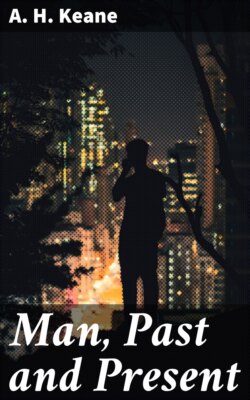Читать книгу Man, Past and Present - A. H. Keane - Страница 22
На сайте Литреса книга снята с продажи.
ОглавлениеArts and Industries.
Yet many of these cannibal peoples, especially the Mangbattus and Zandehs, are skilled agriculturists, and cultivate some of the useful industries, such as iron and copper smelting and casting, weaving, pottery and wood-carving, with great success. The form and ornamental designs of their utensils display real artistic taste, while the temper of their iron implements is often superior to that of the imported European hardware. Here again the observation has been made that the tribes most addicted to cannibalism also excel in mental qualities and physical energy. Nor are they strangers to the finer feelings of human nature, and above all the surrounding peoples the Zandeh anthropophagists are distinguished by their regard and devotion for their women and children.
High Appreciation of Pictorial Art.
In one respect all these peoples show a higher degree of intelligence even than the Arabs and Hamites. "My later experiences," writes Junker, "revealed the remarkable fact that certain negro peoples, such as the Niam-Niams, the Mangbattus and the Bantus of Uganda and Unyoro, display quite a surprising understanding of figured illustrations or pictures of plastic objects, which is not as a rule exhibited by the Arabs and Arabised Hamites of North-east Africa. Thus the Unyoro chief, Riongo, placed photographs in their proper position, and was able to identify the negro portraits as belonging to the Shuli, Lango, or other tribes, of which he had a personal knowledge. This I have called a remarkable fact, because it bespoke in the lower races a natural faculty for observation, a power to recognise what for many Arabs or Egyptians of high rank was a hopeless puzzle. An Egyptian pasha in Khartum could never make out how a human face in profile showed only one eye and one ear, and he took the portrait of a fashionable Parisian lady in extremely low dress for that of the bearded sun-burnt American naval officer who had shown him the photograph[221]." From this one is almost tempted to infer that, amongst Moslem peoples, all sense of plastic, figurative, or pictorial art has been deadened by the Koranic precept forbidding the representation of the human form in any way.
Sense of Humour.
The Welle peoples show themselves true Negroes in the possession of another and more precious quality, the sense of humour, although this is probably a quality which comes late in the life of a race. Anyhow it is a distinct Negro characteristic, which Junker was able to turn to good account during the building of his famous Lacrima station in Ndoruma's country. "In all this I could again notice how like children the Negroes are in many respects. Once at work they seemed animated by a sort of childlike sense of honour. They delighted in praise, though even a frown or a word of reproach could also excite their hilarity. Thus a loud burst of laughter would, for instance, follow the contrast between a piece of good and bad workmanship. Like children, they would point the finger of scorn at each other[222]."
One morning Ndoruma, hearing that they had again struck work, had the great war-drum beaten, whereupon they rushed to arms and mustered in great force from all quarters. But on finding that there was no enemy to march against, and that they had only been summoned to resume operations at the station, they enjoyed the joke hugely, and after a general explosion of laughter at the way they had been taken in, laid aside their weapons and returned cheerfully to work. Some English overseers have already discovered that this characteristic may be utilised far more effectively than the cruel kurbash. Ethnology has many such lessons to teach.
